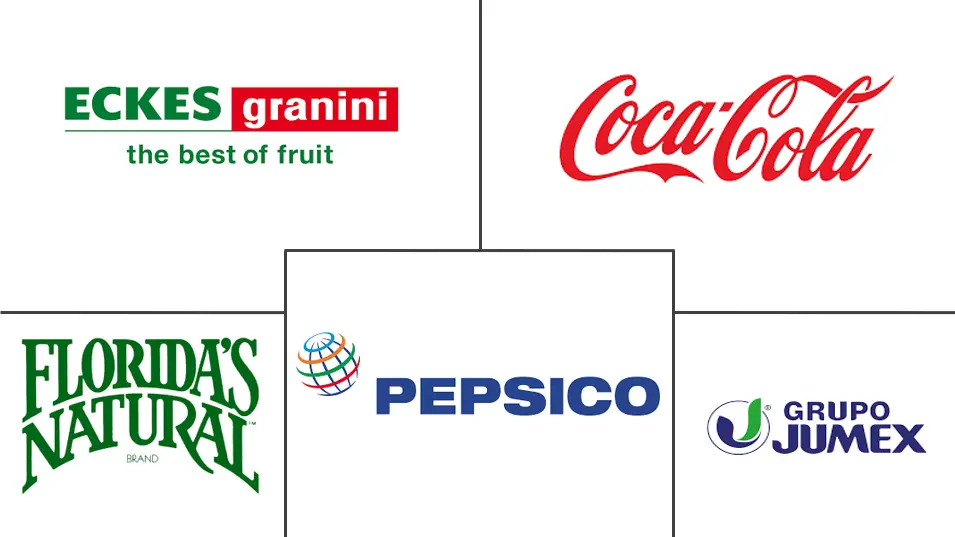NFC Juice Market Size and Share
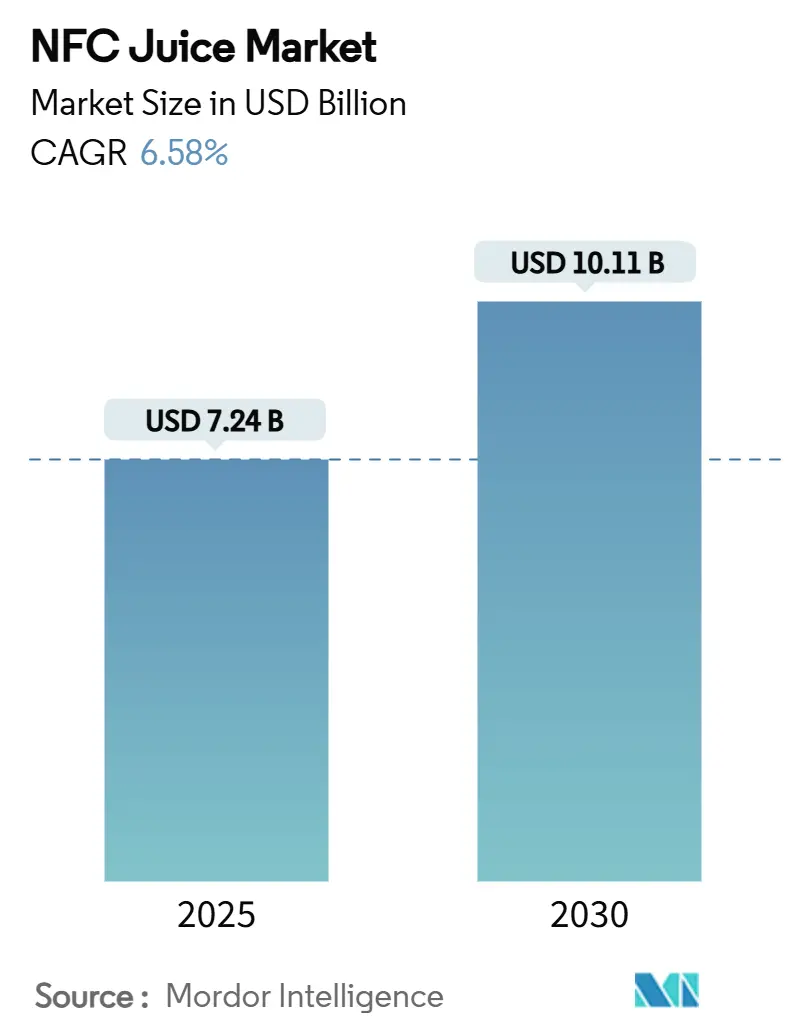
NFC Juice Market Analysis by Mordor Intelligence
The NFC juice market size stands at USD 7.24 billion in 2025 and is projected to reach USD 10.11 billion by 2030, advancing at a 6.58% CAGR over the forecast period. Growth is powered by high-pressure processing and cold-press extraction that lengthen shelf life while preserving authentic flavors, enabling brands to charge premium prices. Rising consumer scrutiny of ingredient transparency pushes retailers to stock minimally processed options, reinforcing volume gains for value-added formulations. Robust cold chain investments and e-commerce logistics further lower spoilage risk, widening geographic access to chilled products. The competitive landscape exhibits moderate concentration, indicating strategic consolidation opportunities while maintaining space for innovative entrants to capture niche segments. Supply diversification, particularly away from disease-prone citrus, supports steady raw-material availability and buffers price volatility.
Key Report Takeaways
- By product type, fruit juice led with 63.42% of NFC juice market share in 2024, while vegetable juice posted the highest forecast growth at 7.33% CAGR to 2030.
- By category, conventional products held 85.82% of the NFC juice market size in 2024, whereas organic products are expanding at 9.18% CAGR through 2030.
- By packaging type, PET bottles contributed 36.47% revenue in 2024; pouches represent the fastest-growing container at 7.65% CAGR to 2030.
- By distribution channel, hypermarkets and supermarkets accounted for 42.76% of the 2024 value, while online retail advances at 10.49% CAGR during 2025-2030.
- By geography, North America dominated with 31.65% regional share in 2024; Asia-Pacific exhibits the strongest regional momentum at 8.22% CAGR through 2030.
Global NFC Juice Market Trends and Insights
Drivers Impact Analysis
| Driver | (~) % Impact on CAGR Forecast | Geographic Relevance | Impact Timeline |
|---|---|---|---|
| Growing Demand for Clean-label Beverages | +1.2% | Global, with strongest impact in North America & Europe | Medium term (2-4 years) |
| Demand for Minimally Processed Juices | +0.8% | North America & EU core, spillover to APAC | Short term (≤ 2 years) |
| Expansion of Premium and Organic Product Lines | +0.6% | Europe & North America, emerging in APAC urban centers | Long term (≥ 4 years) |
| Launch of high-pressure-processed (HPP) NFC SKUs | +0.4% | North America & Europe, with technology transfer to APAC | Medium term (2-4 years) |
| Advancements in Cold-Press and Gentle Processing Technology | +0.3% | Global, with early adoption in developed markets | Long term (≥ 4 years) |
| Flavor Innovation and Exotic Blends | +0.2% | APAC core, with expansion to global markets | Short term (≤ 2 years) |
| Source: Mordor Intelligence | |||
Growing Demand for Clean-label Beverages
Consumers are now scrutinizing ingredient lists not just for health reasons, but also for transparency in processing and the origins of the supply chain. This shift is evident as 85% of retailers now prioritize stocking fresh, minimally processed options, leading to a fundamental change in their procurement strategies. The clean-label movement offers a competitive edge to NFC producers who can showcase minimal processing, while also pressuring traditional juice manufacturers to either reformulate their products or risk losing market share. Regulatory bodies are adapting to this trend, with the EU mandating that all packaging materials be reusable or recyclable by 2030. This move bolsters the sustainability narrative central to the clean-label movement. Economically, the implications are significant: beyond just premium pricing, clean-label positioning allows manufacturers to achieve higher profit margins and foster brand loyalty in a market that's becoming increasingly commoditized.
Demand for Minimally Processed Juices
Amid rising consumer skepticism towards industrial food processing, the minimally processed juice segment is carving out a niche. Instead of relying solely on marketing, this segment is leveraging technology for differentiation. Adoption of high-pressure processing (HPP) has surged, with over 200 machines now operational across the U.S. This technology allows manufacturers to boost juice shelf life from a mere week to an impressive 30 days, all while preserving nutritional integrity. Such advancements tackle the age-old dilemma of balancing freshness with commercial viability, a challenge that has historically hindered the expansion of the NFC market. In a notable stride, Cornell AgriTech has pioneered a combined pulsed electric field (PEF) and HPP processing method. This innovation not only underscores the successful translation of academic research into commercial use but also boasts superior retention of antioxidants and anthocyanins over conventional techniques. Further bolstering these advancements, regulatory bodies have lent their stamp of approval. Notably, Health Canada has validated HPP for raw fruit juices, endowing manufacturers with the scientific credibility to confidently position their products at a premium.
Expansion of Premium and Organic Product Lines
Premium and organic juice segments are experiencing structural growth driven by demographic shifts and regulatory mandates rather than cyclical consumer trends. The EU's target of 25% organic farming by 2030 creates supply chain imperatives that extend beyond consumer preference to regulatory compliance, fundamentally altering raw material sourcing strategies. The price elasticity of -2.580 for super-premium beverages suggests that while consumers are price-sensitive, they maintain purchasing behavior when products deliver demonstrable health benefits. This dynamic creates opportunities for NFC producers to capture value through product differentiation rather than competing solely on cost. As health-conscious consumers increasingly prioritize organic and premium products, brands are responding with innovative marketing strategies, emphasizing the health benefits and superior quality of their offerings. Furthermore, collaborations with health influencers and nutritionists are becoming commonplace, bolstering brand credibility and driving consumer trust. Industry players are also exploring sustainable packaging solutions, aligning with the eco-conscious values of their target demographic.
Launch of high-pressure-processed (HPP) NFC SKUs
HPP technology is revolutionizing juice processing, tackling various market challenges, and reshaping competitive dynamics. The FDA's endorsement of HPP as a legitimate pathogen reduction method, alongside the 5-log reduction standard, offers the regulatory clarity needed to boost investments in processing infrastructure. This technology, effective for beverages with pH levels under 4.6, aligns seamlessly with most fruit juice applications. Moreover, the need for hermetically sealed packaging is spurring innovations in sustainable packaging solutions. Health Canada's endorsement of HPP for raw fruit juices, specifying 80,000 psi for durations of 1-9 minutes, underscores the technology's global regulatory acceptance, paving the way for market expansion across borders[1]Source: Health Canada, “Novel Food Information – High Pressure Processing-Treated Raw Fruit Juices,” canada.ca. Additionally, the Cold Pressure Council's certification seal program not only raises consumer awareness but also presents brands with unique marketing positioning opportunities, transcending mere processing technology.
Restraints Impact Analysis
| Restraint | (~) % Impact on CAGR Forecast | Geographic Relevance | Impact Timeline |
|---|---|---|---|
| Shorter Shelf Life Compared to Concentrated Juices | -0.7% | Global, with acute impact in regions with limited cold chain | Short term (≤ 2 years) |
| High Production and Storage Costs | -0.5% | North America & Europe, with cost pressures in emerging markets | Medium term (2-4 years) |
| Supply Chain Vulnerabilities Due to Seasonality | -0.4% | Global, with severe impact in citrus-dependent regions | Long term (≥ 4 years) |
| Stringent Cold Chain Infrastructure Requirements | -0.3% | APAC & MEA, with infrastructure gaps limiting market penetration | Long term (≥ 4 years) |
| Source: Mordor Intelligence | |||
Shorter Shelf Life Compared to Concentrated Juices
The trade-off between freshness and shelf stability leads to cost disadvantages that go beyond just spoilage, affecting inventory management and distribution. While NFC products need refrigerated storage throughout the supply chain, concentrated alternatives can be stored at ambient temperatures for longer. This difference in storage creates escalating cost disparities at each stage of distribution. The USDA's endorsement of pasteurized juice for Child Nutrition programs highlights institutional buyers' preference for shelf-stable products, which in turn restricts NFC's penetration in high-volume markets[2]Source: USDA Food and Nutrition Service, “Pasteurized Juice,” fns.usda.gov. Although HPP technology can extend the refrigerated shelf life of products to 30 days, the high capital investment and processing costs pose challenges, especially for smaller manufacturers. This economic challenge is magnified in areas with inconsistent cold chain infrastructure, where losses can surpass 20% of the total production value.
High Production and Storage Costs
Specialized equipment, refrigerated storage, and swift distribution networks pose economic challenges for NFC production. In contrast, alternatives like concentrated juice sidestep these hurdles. While investing in HPP equipment can prolong shelf life, the associated capital costs are often too steep for smaller processors, especially without firm volume commitments from major retailers. Lassonde Industries' USD 200 million bet on a New Jersey facility underscores the hefty capital needed for competitive cost structures in NFC production. Their further USD 20 million boost to a North Carolina facility highlights the relentless capital demands for staying efficient in a price-sensitive arena. Such substantial investments not only fortify the positions of established players but also elevate entry barriers for newcomers, fueling market consolidation.
Segment Analysis
By Product Type: Fruit Dominance Drives Vegetable Innovation
Fruit juice controlled 63.42% of the NFC juice market share in 2024, anchored by entrenched consumption of orange, apple, and mixed-citrus SKUs. However, vegetable juices are forecast to post a 7.33% CAGR, the fastest within the segment, propelled by consumers who seek greens-based functional benefits without compromising taste. Manufacturers respond by blending carrot, spinach, or beet cues with fruits to mask vegetal notes, aided by cold-press methods that maintain freshness. Technology enables enzymes to remain active, enhancing nutrient perception and justifying premium shelf tags. HPP compatibility further widens retail acceptance, letting blended SKUs share cooler space with mainstream variants.
Vegetable-forward portfolios also hedge citrus-disease risk, diversifying ingredient baskets while improving antioxidant profiles. Cornell AgriTech’s work on Concord grape preserves anthocyanins under cold-press regimes, offering blue-purple hues that attract wellness-oriented shoppers. Category storytelling now links color to polyphenol concentration, adding educational appeal in digital campaigns. Higher fiber content differentiates vegetable blends from sugar-centric nectars, aligning with low-GI dietary preferences among millennials. As recipe databases expand, contract packers replicate bestseller formulas, scaling distribution beyond specialty stores into mass grocery aisles.
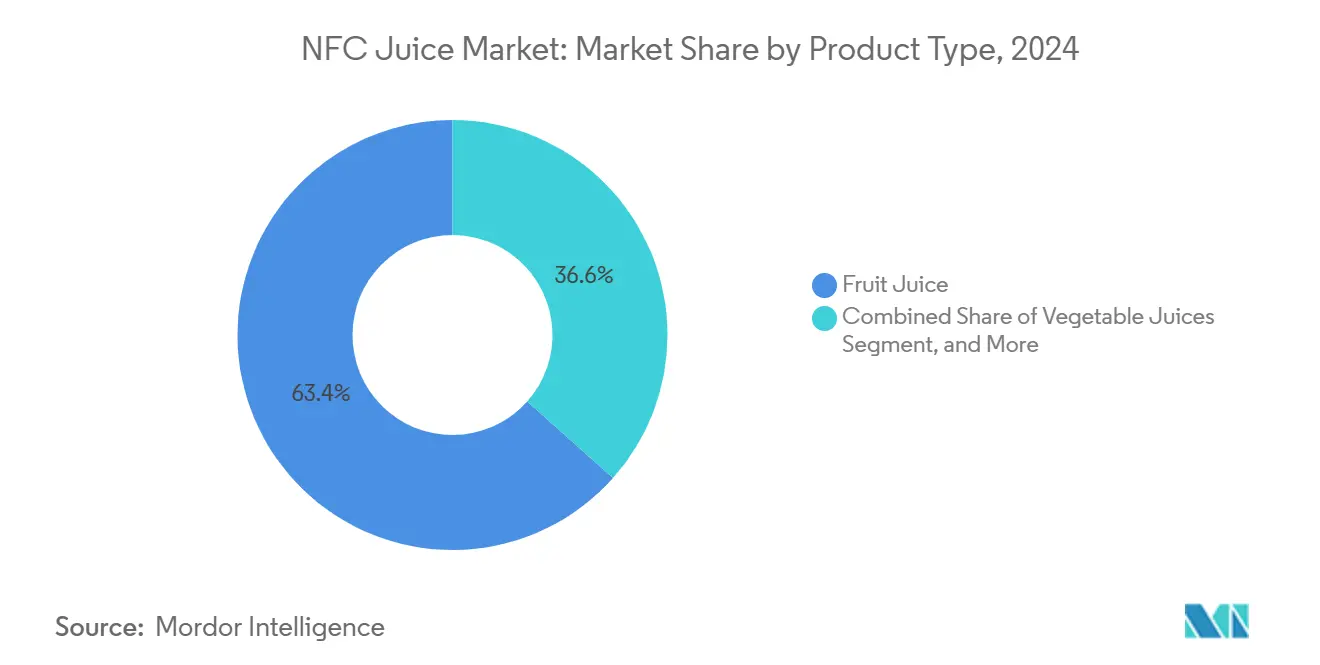
Note: Segment shares of all individual segments available upon report purchase
By Category: Organic Acceleration Challenges Conventional Dominance
Conventional SKUs maintained 85.82% of 2024 volume thanks to cost leadership, but organic lines are accelerating at 9.18% CAGR, outpacing total NFC juice market growth. Farmers converting acreage to organic crops lock in price premiums, encouraging dedicated supply chains that guarantee pesticide-free inputs. Europe’s farm-to-fork strategy, targeting 25% organic farmland by 2030, institutionalizes demand, while U.S. retailers add private-label organics to capture share. The NFC juice market size for organic beverages is forecast to expand steadily as trust in certification seals deepens among young families concerned about residue exposure.
Organic processors deploy HPP to achieve the requisite shelf life without chemical additives, preserving eco-positioning. Carbon-neutral bottling lines and lightweight rPET bottles reduce scope 3 emissions, reinforcing Organic’s sustainability halo. Conventional firms counterattack with “spray-free” or “natural” sub-brands priced beneath certified organics, yet labelling clarity laws in Europe may limit this strategy’s lifespan. As agricultural subsidies pivot toward regenerative practices, cost gaps between conventional and organic juices could narrow, eroding the former’s price advantage.
By Packaging Type: Sustainability Reshapes Container Economics
PET bottles delivered 36.47% of the 2024 value because of low cost, shatter resistance, and established curbside recycling. Nonetheless, pouches are projected to grow at 7.65% CAGR as portion control converges with lightweight logistics, slashing transport emissions per liter. European regulations stipulating that all packaging be reusable or recyclable by 2030 speed innovation toward mono-material laminates that simplify recycling streams[3]Source: CBI, “Trends in the European Processed Fruit and Vegetables Market,” cbi.eu. Glass retains niche upscale appeal but faces higher freight costs and breakage losses, prompting retailers to cap glass facings.
HPP compatibility demands hermetic sealing; thus, multilayer pouches and thicker-wall PET gain favor to withstand 80,000 psi pressures. Emerging solutions include tethered caps that comply with EU single-use plastic rules and easy-peel valves that minimize oxygen ingress. Refillable stainless-steel growlers piloted in select U.S. grocery chains provide zero-waste alternatives, though cleaning logistics remain complex. As lifecycle assessments inform procurement, brands quantify carbon savings per container, translating sustainability efforts into QR-linked storytelling that drives shopper engagement.
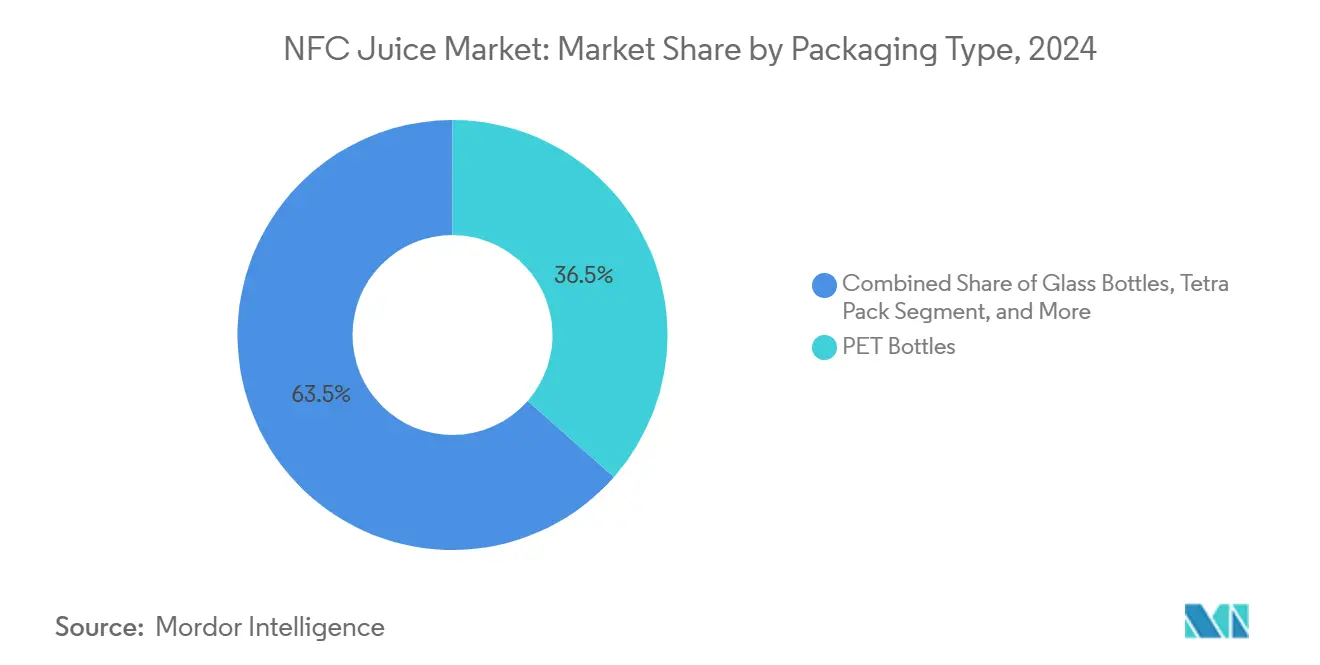
Note: Segment shares of all individual segments available upon report purchase
By Distribution Channel: Digital Transformation Accelerates Direct Access
Hypermarkets and supermarkets controlled 42.76% of the 2024 NFC juice market size thanks to built-out chillers and one-stop shopping convenience. Yet online retail will expand at 10.49% CAGR as cold-chain last-mile services mature and subscription models lock in recurring revenue. Direct-to-consumer sites bundle juices with wellness plans, supplying personalization leverage that brick-and-mortar formats lack. Retailers counter with click-and-collect chill lockers, blending online ease with in-store pickup.
Convenience and grocery stores benefit from impulse-driven single-serve SKUs, especially morning commuters seeking grab-and-go nutrition boosts. Foodservice and cafés remain valuable for brand trial: limited-time exotic blends create buzz before mass retail rollout. Omnichannel analytics unify loyalty data, guiding targeted promotions such as buy-two-get-one emails timed to subscription renewal cycles. Firms integrating ERP feeds with real-time inventory apps reduce out-of-stock episodes, a key to preventing shopper migration to competing beverage categories.
Geography Analysis
In 2024, North America commands a 31.65% market share, bolstered by a well-established consumer base for premium juice products and a strong cold chain infrastructure that streamlines NFC distribution. This market dominance is a testament to the region's historical investments in processing technologies and supportive regulatory frameworks that foster product innovation. Yet, challenges loom: supply chain disruptions from citrus greening disease and climate-related issues, highlighted by Florida's orange production hitting a 95-year low. In response, manufacturers are diversifying their supply sources and exploring alternative fruits, altering the competitive landscape of the region.
Asia-Pacific stands out as the region with the most rapid growth, boasting an 8.22% CAGR projected through 2030. This surge is largely attributed to rising disposable incomes and a heightened health consciousness among urban dwellers. Notably, Coca-Cola's Q1 2025 report highlighted a 1% uptick in its juice segment, predominantly spurred by the Asia-Pacific market, underscoring the success of major players in harnessing regional growth[4]Source: The Coca-Cola Company, “Q1 2025 Earnings Release,” coca-cola.com. The region's upward trajectory is further supported by advancements in infrastructure and an expanding cold chain, paving the way for NFC market penetration in areas previously overlooked.
Europe, with its mature market, is at the forefront of sustainability, driven by intricate regulatory frameworks. The EU's ambitious Green Deal, aiming for climate neutrality by 2050, offers a competitive edge to manufacturers who proactively invest in sustainable processing and packaging. Meanwhile, South America and the Middle East & Africa present tantalizing growth prospects. However, these opportunities are tempered by challenges: limitations in cold chain infrastructure and economic fluctuations that hinder the adoption of premium products. To navigate these waters, a localized approach is essential, striking a balance between market growth and managing operational risks.
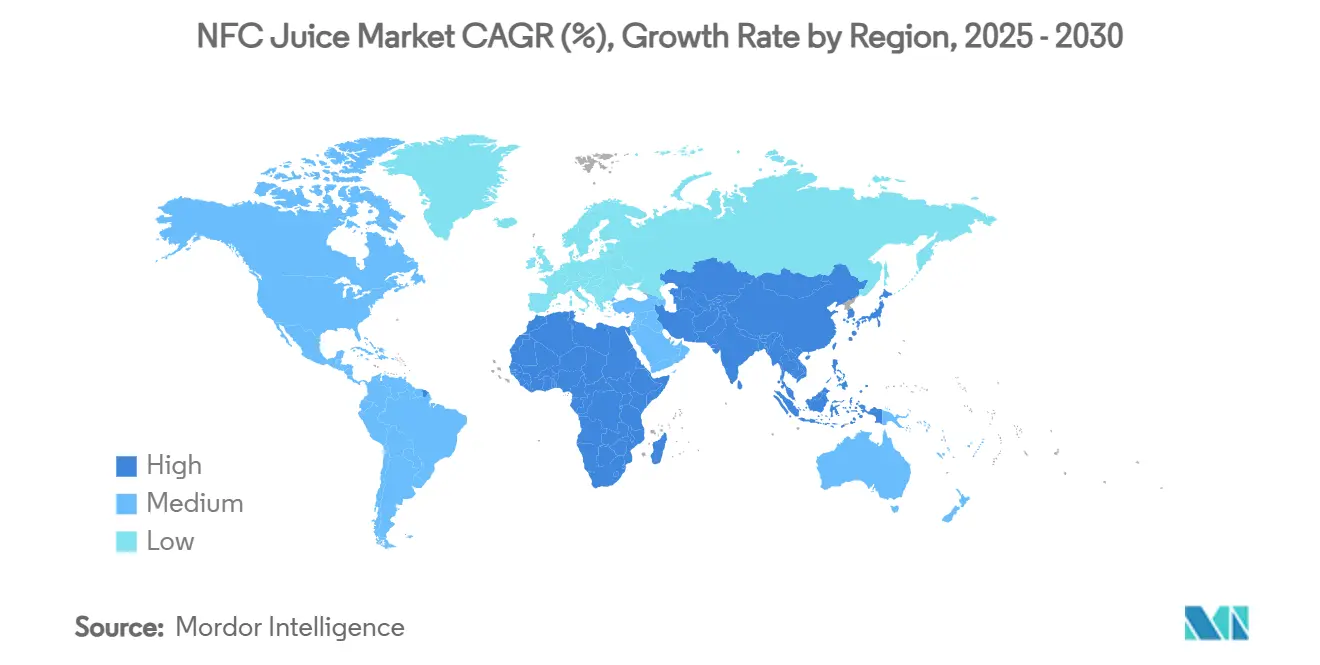
Competitive Landscape
The NFC juice market, characterized by a moderate concentration, signals both strategic consolidation opportunities and a competitive landscape that prizes innovation and operational efficiency. Major players, such as PepsiCo and Coca-Cola, alongside regional specialists like Lassonde Industries, are not just competing on price. Instead, they're focusing on technology adoption, optimizing their supply chains, and managing diverse brand portfolios. This shift in competitive intensity marks the market's evolution: moving from a commodity-based competition to one that emphasizes value-added differentiation. This differentiation is achieved through advanced processing technologies, organic certifications, and eco-friendly packaging solutions.
Strategic patterns in the market showcase a dual approach. Established players are harnessing their scale for cost advantages, yet they're also making significant strides into premium segments. This is evident through their organic acquisitions and tech partnerships. A case in point is PepsiCo's USD 3 billion divestiture of Tropicana, where it smartly retained a 39% stake. This move underscores a broader trend of portfolio optimization, allowing giants to hone in on core strengths while still riding the wave of growth segments.
Meanwhile, emerging disruptors are making waves with direct-to-consumer strategies and niche processing technologies. Notably, acquisitions like Perricone Farms' buyout of Natalie's Orchid Island highlight the trend towards regional consolidations. On the regulatory front, the FDA's HACCP mandates present hurdles that predominantly benefit established players. These players not only boast the necessary compliance infrastructure but also leverage it to validate their premium brand positioning.
NFC Juice Industry Leaders
-
Eckes-Granini Group
-
Florida’s Natural Growers
-
Grupo Jumex
-
The Coca-Cola Company
-
PepsiCo Inc
- *Disclaimer: Major Players sorted in no particular order
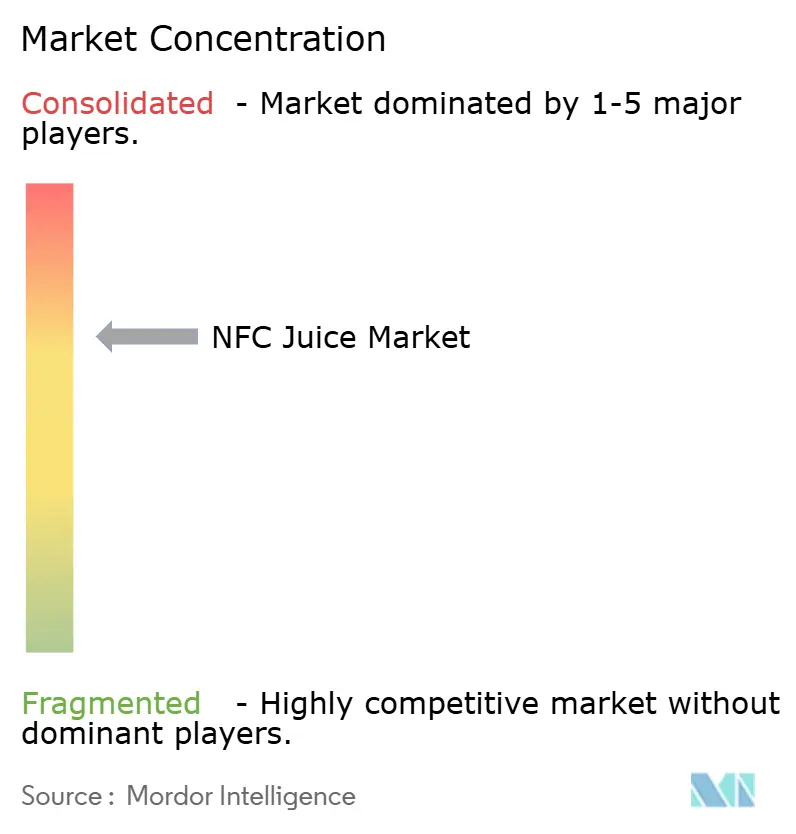
Recent Industry Developments
- April 2025: Castillo Hermanos agreed to acquire Harvest Hill Beverage Co. to reduce cost-to-serve via U.S. manufacturing and enlarge its footprint in premium chilled juices.
- October 2024: Lassonde Industries allocated USD 200 million for a New Jersey facility and an extra USD 20 million for North Carolina upgrades to boost HPP capacity.
- September 2024: Perricone Farms bought Natalie’s Orchid Island Juice, building bicoastal operations that shorten chilled delivery routes.
- May 2024: Cornell AgriTech unveiled a combined PEF-HPP processing method for Concord grape juice that heightens antioxidant retention.
Global NFC Juice Market Report Scope
| Fruit Juice | Orange |
| Apple | |
| Citrus Blend | |
| Tropical | |
| Others | |
| Vegetable Juices | |
| Fruit and Vegetable Blends |
| Conventional |
| Organic |
| PET Bottles |
| Glass Bottles |
| Tetra Pack |
| Cans |
| Pouches |
| Others |
| Hypermarkets and Supermarkets |
| Convenience and Grocery Stores |
| Online Retail |
| Other Retail |
| North America | United States |
| Canada | |
| Mexico | |
| Rest of North America | |
| Europe | Germany |
| United Kingdom | |
| Italy | |
| France | |
| Spain | |
| Netherlands | |
| Poland | |
| Belgium | |
| Sweden | |
| Rest of Europe | |
| Asia-Pacific | China |
| India | |
| Japan | |
| Australia | |
| Indonesia | |
| South Korea | |
| Thailand | |
| Singapore | |
| Rest of Asia-Pacific | |
| South America | Brazil |
| Argentina | |
| Colombia | |
| Rest of South America | |
| Middle East and Africa | South Africa |
| Saudi Arabia | |
| United Arab Emirates | |
| Nigeria | |
| Egypt | |
| Turkey | |
| Rest of Middle East and Africa |
| By Product Type | Fruit Juice | Orange |
| Apple | ||
| Citrus Blend | ||
| Tropical | ||
| Others | ||
| Vegetable Juices | ||
| Fruit and Vegetable Blends | ||
| By Category | Conventional | |
| Organic | ||
| By Packaging Type | PET Bottles | |
| Glass Bottles | ||
| Tetra Pack | ||
| Cans | ||
| Pouches | ||
| Others | ||
| By Distribution Channel | Hypermarkets and Supermarkets | |
| Convenience and Grocery Stores | ||
| Online Retail | ||
| Other Retail | ||
| By Geography | North America | United States |
| Canada | ||
| Mexico | ||
| Rest of North America | ||
| Europe | Germany | |
| United Kingdom | ||
| Italy | ||
| France | ||
| Spain | ||
| Netherlands | ||
| Poland | ||
| Belgium | ||
| Sweden | ||
| Rest of Europe | ||
| Asia-Pacific | China | |
| India | ||
| Japan | ||
| Australia | ||
| Indonesia | ||
| South Korea | ||
| Thailand | ||
| Singapore | ||
| Rest of Asia-Pacific | ||
| South America | Brazil | |
| Argentina | ||
| Colombia | ||
| Rest of South America | ||
| Middle East and Africa | South Africa | |
| Saudi Arabia | ||
| United Arab Emirates | ||
| Nigeria | ||
| Egypt | ||
| Turkey | ||
| Rest of Middle East and Africa | ||
Key Questions Answered in the Report
What is the current value of the NFC juice market?
The NFC juice market size is USD 7.24 billion in 2025 and is forecast to reach USD 10.11 billion by 2030.
Which region leads NFC juice consumption?
North America leads with 31.65% share owing to established cold chains and premium juice demand.
Which product segment is growing fastest?
Vegetable-based NFC juices are projected to grow at 7.33% CAGR through 2030, outpacing all other segments.
How is online retail affecting NFC juice sales?
Online retail is expanding at 10.49% CAGR as subscription models and improved refrigerated logistics broaden direct-to-consumer delivery.
Page last updated on:
